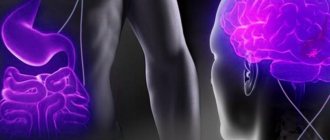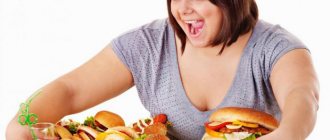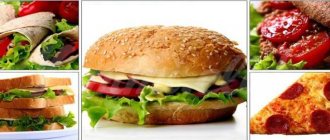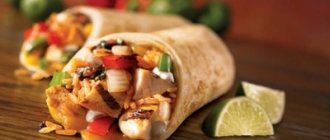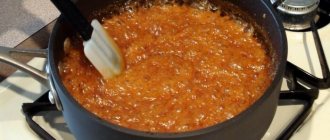A person’s well-being and functional activity of many organs and systems depend on a person’s nutrition. It is especially important to monitor the diet of sick people, because their body is weakened and vulnerable. In the case of diabetes mellitus, diet correction is one of the key components of comprehensive treatment.
There are certain foods that lower blood sugar, which allow you to keep diabetes under control, and sometimes even without taking medications (for example, if we are talking about uncomplicated type 2 diabetes).
Vegetables
Blood sugar-lowering foods to review include many vegetables. Vegetables are generally divided into 2 categories: non-starchy and starchy.
Starchy types contain more carbohydrates (about 15 g per 0.5 tbsp. when cooked), so their amount should be limited. These include:
- potato;
- pumpkin;
- sweet potato;
- corn;
- yam.
Non-starchy types, on the contrary, allow you to provide the body with all the beneficial compounds without sugar spikes. They should be included in the daily diet in any quantity and combination.
The main types of vegetables that reduce sugar in the body include:
- bell pepper;
- carrot;
- broccoli;
- cauliflower and Brussels sprouts;
- asparagus;
- celery;
- onion;
- tomatoes;
- zucchini;
- garlic.
Nutrition for diabetics
The main therapeutic measure prescribed to all diabetics is diet. It is necessary to stabilize the amount of glucose and subsequently control its content. Nutritional correction is important in prediabetic conditions, along with the use of medications and insulin.
Any diet involves calculating the amount of BZHU, taking into account the specifics of the patient. Nutritional therapy for diabetes excludes foods that increase glucose. Most of them are foods containing light carbohydrates. The daily carbohydrate intake is calculated not in grams, but in grain units.
This is a specific calculation measure used to calculate the optimal level of carbohydrate substances. 1 XE is 12-15 g of digestible glucose. This amount of carbohydrates leads to an increase in content by the same amount - 2.8 mmol/l, increasing the need for insulin by 2 units.
The daily norm of bread units can only be determined with the help of a doctor. The specifics of the clinical picture, the causes of diabetes, the age, gender, and body weight of the patient are taken into account.
The therapeutic diet also requires compliance with the following rules:
- The amount of calories consumed must exactly match the body's needs.
- Strict adherence to the balance of BZHU
- Fractional diet (small portions up to 8 times)
- Consuming both animal and plant sources of nutrients
- Drinking regimen (daily from 1 liter of liquid)
- Avoiding foods that increase glucose
- Proper heat treatment (excluding fried, smoked, canned, pickled foods if possible)
- Limited salt intake (up to 10 g in pure form)
- Maintaining a general regimen (eating at the same time every day)
Patients diagnosed with diabetes are prescribed a therapeutic diet, the main task of which is to prevent an increase in glucose levels.
Fruits
Foods that lower blood sugar, the list of which consists mainly of protein foods, also contains some fruits.
Thus, ripe fruits demonstrate a higher GI than those that are not fully ripe. This primarily applies to peaches, apricots and nectarines. Eating some fruits (kiwis, pears, apples) with the peel may be healthier because it contains more fiber and can help regulate blood sugar levels.
All types of low GI fruits can help lower blood sugar levels. These include:
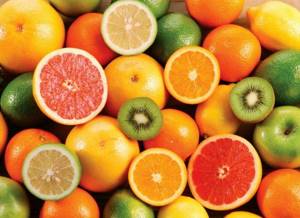
- citrus fruits (grapefruit and orange);
- apples;
- pears;
- peaches;
- plums;
- kiwi.
All of these types are rich in fiber and contain plant compounds that are beneficial to the body, including naringenin and polyphenol, which have powerful antidiabetic properties.
Greenery
Leafy greens are low in calories and high in fiber, nutrients and phytochemicals. Therefore, it can lower blood sugar levels and provide the body with vitamin C and antioxidants, which speed up metabolism and help maintain a high level of immunity. All its types also contain very few fast carbohydrates.
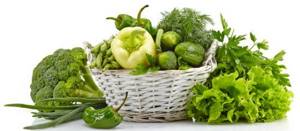
The most beneficial types of leafy greens are:
- spinach;
- leaf salad;
- arugula;
- romaine lettuce;
- all types of kale (kale, Chinese);
- celery leaves.
Additionally, spinach, kale and other leafy greens are good sources of lutein and zeaxanthin. These compounds protect the eyes from macular degeneration and cataracts, which are common complications of diabetes.
What is diabetes and blood sugar levels?
Diabetes mellitus is a modern disease. This condition affects many people, regardless of age and gender. The pathology manifests itself as an increase in blood glucose, which is accompanied by characteristic unpleasant symptoms.
There is a headache, severe weakness, dizziness, dry mouth, frequent urination, and a strong feeling of thirst.
This clinical condition has 2 types: insulin-dependent and non-insulin-dependent.

The normal level of glucose in the body is up to 5.5 mmol/l. The examination is carried out on an empty stomach. If the sugar level is more than or equal to 6.7 mmol/l for a long time, diabetes mellitus is confirmed.
Berries
Foods that lower blood sugar (listed based on GI index) include almost all fresh berries. Thus, strawberries, blueberries, blackberries and raspberries have a low GI and offer a range of beneficial properties.
The combination of a small percentage of sugar and a large amount of fiber allows them to lower glucose levels. In addition, it has been proven that regularly consuming foods rich in polyphenols (a natural chemical found in large quantities in berries) can reduce the formation of fat cells by 73%.
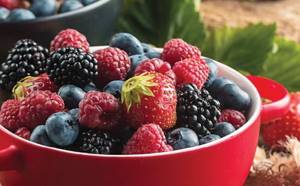
The list of foods to lower blood sugar includes almost all fresh berries. Strawberries, raspberries, blueberries and blackberries are considered especially useful.
Berries are rich in antioxidants, which help prevent oxidative stress, thereby preventing the development of many dangerous diseases. In general, oxidative stress occurs at chronic levels in people with diabetes, and daily intake of antioxidants is required to combat it.
In addition, all types of berries are rich in fiber, vitamins and potassium, necessary for the proper functioning of blood vessels and the heart.
What you shouldn't eat
There are a number of products, the intake of which provokes a very sharp jump in glucose levels. If you have diabetes, to maintain your own health, you should eliminate as much as possible from your diet the following foods:
- carbonated drinks;
- conservation;
- smoked meats;
- lard, sausages;
- various semi-finished products;
- ketchup;
- sweets, jam.
You need to understand that it will not be possible to completely eliminate carbohydrates from your diet. Your preference should be given to foods that will consist of complex carbohydrates, for example:
- whole wheat bread;
- greenery;
- unpolished rice;
- wheat and buckwheat porridge.
Fish and seafood
Fish and seafood (such as shellfish and shrimp) are rich in protein, healthy fats, vitamins and minerals. The large amount of antioxidants they contain (especially in fatty fish - sardines, salmon, etc.) can play a significant role in reducing sugar levels.
These foods not only slow down the digestive process and control post-meal glucose spikes, but also promote weight loss by preventing overeating. Oily fish is a healthy addition to any diet. It contains important omega-3 fatty acids called eicosapentaenoic acid (EPA) and docosahexaenoic acid (DHA).

A person needs a certain amount of healthy fats to keep the body functioning, especially the heart and brain. Active consumption of fatty acids can lower lipid and glucose levels in both healthy people and diabetics.
Some types of fish are rich sources of both polyunsaturated and monounsaturated fats. First of all this:
- salmon;
- mackerel;
- sardine;
- albacore (a type of tuna);
- herring;
- trout.
Legumes
Foods that lower blood sugar (the list contains a variety of categories) are represented by most legumes. These plant crops provide the body with an excellent combination of plant proteins and soluble fiber, which increases the feeling of fullness and helps control sugar levels. Therefore, it is recommended to replace some of the meat in the menu with legumes.
A significant part of the carbohydrates in their composition is presented in the form of so-called resistant starch, which has a minimal effect on sugar levels.
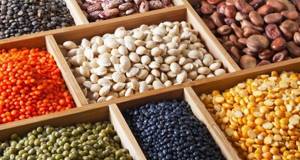
This is because it is not digested as it passes through the body, and ends up feeding the beneficial bacteria in the final part of the digestive tract. As a result, legumes not only reduce blood sugar, but also help improve gut health.
This category includes the following products:
- white, red and black beans;
- chickpeas;
- red and green lentils.
Sugar substitutes
With elevated blood glucose levels, avoiding sweet and high-carbohydrate foods comes to the fore, but few patients find such changes easy, so scientists have researched and approved various sugar substitutes. While similar in sweetness, they are much less harmful to health because they are based not on sucrose (the root of all problems), but on other substances. Among natural and synthetic sweeteners, the most famous are stevia, cyclamate, lactulose, sucralose, thaumatin, fructose, sorbitol and xylitol. They all have varying degrees of sweetness and chemical properties, but their common feature is that they are harmless for diabetes.
Meat, poultry and offal
If you're cutting back on carbohydrates in your diet, you should start eating larger portions of meat to stay full. However, red types are not recommended, especially in processed form (sausages, bacon), as they can provoke the development of cancer.

Instead of beef, lamb and pork, you should add more poultry (turkey and chicken), as well as their offal and eggs to the menu. All these menu components, when consumed regularly, can reduce the amount of sugar in the body and increase insulin sensitivity.
Rules of diet therapy
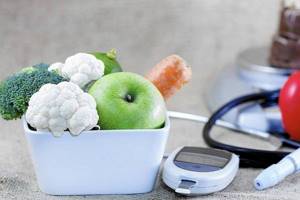
The intake of fast carbohydrates and fats into the body are the main causes of diabetes. Therefore, at any stage of the pathology you need to adhere to a special diet. Losing weight is contraindicated through a strict diet or fasting. Patients with diabetes should adhere to the following general principles:
- each serving should not exceed 200 g;
- food intake is increased to 5-6 times a day;
- reduce the total calorie intake;
- drink at least 2.5 liters of water per day;
- significantly reduce the consumption of sugar and salt, vegetable fats;
- It is better to bake, boil or steam dishes.
The main measure of nutrition is the bread unit, or carbohydrate unit (XU), an indicator of the carbohydrate content in foods. The menu for diabetics should be prepared by a specialist. It takes into account the severity of the condition, the patient’s age and lifestyle, and the presence of chronic pathologies.
Nuts
Many whole nuts (such as almonds, hazelnuts and peanuts) can play a significant role in reducing blood sugar.

Nuts have a low glycemic index and are high in fiber and healthy fat. They also contain nutrients and vitamins such as vitamin E, omega-3 and magnesium that improve heart function. Adding nuts and pastes made from them to the menu allows you to make your diet balanced.
GI table
The glycemic index is a number assigned to foods to indicate how quickly they will affect your blood glucose levels (on a scale from 1 to 100). To control sugar levels, you should create a menu consisting primarily of low GI foods.
Products with a higher indicator are allowed if they are consumed together with non-carbohydrate components consisting of proteins and fats (meat and fish products, eggs). This softens the effect of carbohydrates and slows down the release of sugars into the bloodstream.

| Product name | GI indicator | Product name | GI indicator |
| Vegetables | Cereals | ||
| Green peas (raw) | 39 | Brown rice | 49 |
| Corn kernels (raw) | 47 | White rice | 55 |
| Raw carrots | 16 | Couscous | 65 |
| Boiled carrots | 41 | Cereals | 70 |
| Eggplant | 15 | Buckwheat | 51 |
| Broccoli | 10 | Pearl barley | 22 |
| Cauliflower | 15 | Wild rice | 57 |
| White cabbage | 10 | Dairy | 31 |
| Tomatoes | 15 | Whole milk | 31 |
| Chilli | 10 | Skimmed milk | 32 |
| Green bean | 10 | Unsweetened yogurt | 33 |
| Bell pepper | 15 | Kefir | 23 |
| Bulb onions | 10 | Berries | |
| Parsnip | 9 | Cherry | 22 |
| Raw pumpkin | 75 | Strawberry | 11 |
| Boiled pumpkin | 64 | Blueberry | 15 |
| Boiled sweet potatoes (yam) | 63 | Raspberries | 15 |
| Boiled potatoes | 78 | Blueberry | 21 |
| Frozen mixed vegetables for soup | 48 | Leafy greens | |
| Beet | 64 | Celery | 15 |
| Fruits | Lettuce | 10 | |
| Plums | 24 | Legumes | |
| Peaches | 28 | Canned beans without sauce | 52 |
| Apples | 34 | Canned beans in tomato sauce | 56 |
| Pears | 41 | Boiled beans | 31 |
| Grape | 43 | Cooked pinto beans | 45 |
| Coconut | 45 | Boiled butter beans | 36 |
| Kiwi | 47 | Peas | 42 |
| Mango | 60 | Red lentils | 21 |
| Watermelon | 72 | Green lentils | 30 |
| Figs | 61 | Yellow split peas | 32 |
| A pineapple | 66 | Nuts and seeds | |
| Orange | 40 | Peanut | 14 |
| Grapefruit | 25 | Cashew | 21 |
| Banana | 62 | Almond | 15 |
| Papaya | 60 | Brazilian nut | 20 |
| Raisin | 64 | Hazelnut | 20 |
| Dried apricots | 32 | Macadamia | 20 |
| Prunes | 29 | Pecan | 20 |
| Dates | 42 | Pistachios | 20 |
Foods with high and medium GI
There is no need to calculate the glycemic index yourself. There is a ready-made table of foods that are excluded from the diet of a diabetic patient.
| Products | G.I. |
| dates | 146 |
| wheat bread (white) | 136 |
| cakes, cookies, croutons (fried) | 100 |
| potatoes (fries and fried) / mashed | 95/90 |
| pies and buns | 88 |
| corn flakes, popcorn and pasta | 85 |
| rice porridge, waffles, caramel candies | 80 |
| fried zucchini, baked pumpkin | 75 |
| seasoned croutons, soda | 74 |
| watermelon | 72 |
| cheesecakes, ice cream, jam (jams), milk chocolate, halva, dumplings | 70 |
Nutritional features must comply with:
- stages of the disease (compensated, subcompensated, decompensated);
- type of disease (insulin dependent, non-insulin dependent);
- prescribed doses of medications;
- the presence of complications and concomitant pathologies;
- general condition of the patient;
- level of physical activity.
Depending on the listed individual health indicators, food with an average GI value is allowed. The treating endocrinologist can best advise which foods should be avoided and which ones can be eaten. The table shows limited products with an average glycemic index.
| Products | Gl |
| unleavened dough (flatbread, pita without filling) | 69 |
| croissants without filling | 67 |
| muesli, pineapple, diet biscuit | 66 |
| bananas, melon, boiled jacket potatoes | 65 |
| raisin | 64 |
| pizza with tomatoes (without meat filling) | 60 |
| papaya | 58 |
| mango, oatmeal cookies, persimmon | 55 |
| yoghurts, tomato soup, gazpacho type | 52 |
| buckwheat, buckwheat flour pancakes | 50 |
| green peas (canned) | 48 |
| beans (white, red), kiwi | 42 |
| chickpeas | 41 |
Excessive consumption of foods from the medium glycemic category can negatively affect health. Sugar will increase depending on the amount eaten, since a larger volume of food containing glucose requires greater insulin costs. With insulin deficiency, hyperglycemia may develop. Proper nutrition is a method of treating diabetes. Neglecting recommendations leads to severe complications of the disease.
Cooking methods and rules
The GI value may vary depending on the cooking time of the product. The longer the heat treatment is carried out, the faster the carbohydrates from its composition will begin to enter the blood. Therefore, it is recommended to cook vegetables not until they are completely soft, but only until they are softened on the outside (they should remain slightly crispy on the inside), and cereals - until al dente.
In addition, highly chopped foods are digested and converted into glucose much faster than those cut into pieces or cooked whole (especially soft vegetables).
You should also adhere to the following cooking rules:
1. Liquid fats instead of solid ones. Solid fats often consist of saturated fats (which should be limited) or trans fats (which should be avoided completely). If a recipe calls for solid fat (butter, lard or margarine), liquid natural vegetable oils should be used instead.

Some of them (particularly canola, corn, olive and grape seed) may be beneficial when consumed in moderation.
2. Low-fat dairy products. Instead of whole milk or 10% cream, it is recommended to use 1% or skim milk. Instead of sour cream, you can add low-fat or fat-free plain yogurt, buttermilk, or even low-fat cottage cheese (you'll likely need to whisk it first to make it smooth).
3. Products with fiber. It is necessary to choose low GI foods that provide energy and contain fiber. A dish prepared from them will retain the ability to reduce sugar levels. If a recipe calls for all-purpose flour, white rice, or other refined grains or grains, substitute whole wheat flour, brown rice, or other whole grains.
Instead of some of the flour, you can also use ground nuts such as almonds or hazelnuts.
4. Elimination of sugar. Unlike carbohydrates from vegetables or starch, which are absorbed slowly, sugar provokes glucose spikes even in small quantities. Therefore, to prepare dishes with low GI, it is necessary to exclude it from the ingredients.
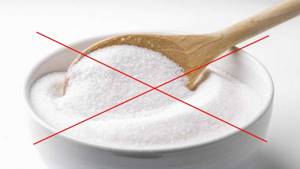
Most often, it does not have a major impact on the taste or texture of the food. The only exception is yeast baked goods, because yeast needs sugar.
What foods lower blood sugar: quickly and effectively
Foods with a low glycemic index help lower glucose quickly and effectively.
These include:
- Spinach.
- Broccoli, artichoke.
- Pumpkin seeds.
- Apricot, peach.
- Ice cream and fresh unsweetened berries.
- Tea with chicory.
- Legumes.
- Greenery.
- Unprocessed rice and other grains.
- Bran.
- Vegetable and fruit juices.
- Vegetable soup.
- Milk serum.
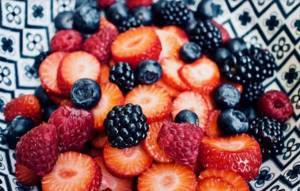
The daily menu must be compiled taking into account these products. It is recommended to control salt intake and replace snacks with raw fruits or vegetables.
Healthy recipes
A combination of poor diet, increased body fat, chronic stress and lack of exercise contribute to increased inflammation, which gradually leads to insulin resistance, persistently high blood sugar levels, and ultimately type 2 diabetes.
Therefore, it is important to create a menu of products that are not only capable of lowering glucose levels, but also have anti-inflammatory properties . Primarily, these are nuts, fish, olive oil, berries and dark leafy greens.
Vegetable bowl with chicken with lemon and tahini sauce
When preparing this dish, it is recommended to fry the vegetables until al dente, rather than soft. This will preserve most of the nutrients.
To prepare the bowl you will need:
- 0.25 tbsp. tahini;
- 0.25 tbsp. cold water plus 2 tbsp. l., separately;
- 0.25 tbsp. lemon juice;
- 0.5 tsp. minced garlic plus 2 cloves, chopped separately;
- 0.25 tsp ground cumin;
- 0.5 tsp. kosher salt;
- 1 tbsp. green beans;
- 1 tbsp. chopped broccoli;
- 4 (160 g each) chicken fillets, chopped;
- 0.25 tsp coarsely ground pepper;
- 2 tbsp. l. olive oil, separated;
- half a large red onion, chopped;
- 4 tbsp. thinly chopped cabbage;
- 2 tbsp. cooked brown rice;
- 0.25 tbsp. chopped fresh cilantro.

The step-by-step cooking process looks like this:
- It is necessary to beat tahini and 0.25 hundred. water in a small container until smooth, add lemon juice, chopped garlic, cumin and 0.25 tsp. salt and beat until smooth.
- Green beans should be trimmed along the edges and cut in half.
- The chicken needs to be seasoned with the remaining 0.25 tsp. salt and coarsely ground pepper.
- Then you need to heat 1 tbsp. l. oil in a large cast-iron skillet over moderate heat, add chicken and cook until an internal temperature of the fillets registers about 73°C on an instant-read thermometer. This will take 3-5 minutes. on each side.
- Transfer the cooked chicken to a clean cutting board and cover with foil to stop it from cooling.
- Wipe the pan and pour in the remaining 1 tbsp. l. oil, add onion and fry, stirring occasionally, for 2 minutes, then add chopped garlic and cook for 30 seconds.
- Then you need to place the broccoli and green beans there, and cook, stirring occasionally, for 2 minutes, then stir in the cabbage and add the remaining 2 tbsp. l. water, cover and simmer until vegetables are tender-crisp, 1-2 minutes.
- To serve, divide the rice and vegetables among 4 bowls and top with shredded chicken, drizzle with the reserved dressing and sprinkle with cilantro.
Stroganoff with mushrooms and chicken
Low-fat sour cream makes a creamy but low-fat sauce for this quick and easy chicken dish.
The following ingredients will be required:
- 0.3 liters of low-fat sour cream;
- 2 tbsp. l. all-purpose flour;
- 1 tbsp. l. Worcestershire chicken marinade;
- 0.5 tsp. dried thyme, chopped;
- 0.5 tsp. instant chicken broth granules;
- 0.25 tsp coarsely ground black pepper;
- 0.5 tbsp. water;
- 1 medium onion, chopped;
- 250 g fresh mushrooms, sliced;
- 1 tbsp. l. canola or olive oil;
- 2 cloves garlic, minced;
- 2.5 tbsp. coarsely chopped chicken meat;
- 3 tbsp. cooked whole grain noodles, hot;
- 1 tomato, chopped.
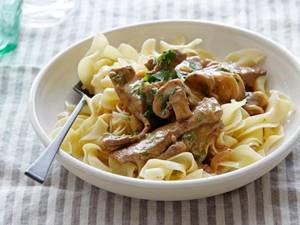
To prepare the dish you will need to follow these steps:
- In a small bowl, mix 2/3 tbsp. sour cream, flour, Worcestershire style marinade, thyme, bouillon granules and pepper, gradually adding water until smooth.
- In a very large frying pan, fry the onions and mushrooms in hot oil over high heat until soft and liquid has evaporated, stirring occasionally, then add the garlic and cook for another 2 minutes until fragrant and golden.
- Then you need to add the chicken and sour cream sauce, and cook, stirring, until it thickens and starts to bubble, then turn it on and simmer, stirring, for another 2 minutes.
- Serve the chicken mixture with the noodles, topping with the remaining sour cream and chopped tomatoes.
Shrimp with vegetables in the microwave
This Asian-inspired shrimp and broccoli dish can be microwaved (instead of pan-frying) and served with steamed brown rice.
You will need the following ingredients:
- 360 g peeled (with tails intact) boiled-frozen shrimp, thawed and dried;
- 0.3 tbsp. light Asian salad dressing;
- 3 tbsp. chopped broccoli florets;
- 0.25 tbsp. water;
- 1 bag of cooked brown rice;
- 1 tbsp. grated carrots;
- 2 tsp. toasted sesame seeds;
- 1 pinch crushed red pepper.

The cooking process is carried out as follows:
- In a medium bowl, combine shrimp and salad dressing, cover and marinate in the refrigerator for 30 minutes, stirring occasionally.
- In a 2-quart microwave-safe glass dish, combine broccoli and water and microwave, covered, on 100% power (high) for 2 minutes, stirring once halfway through cooking; drain in a colander. and return the vegetable to its shape.
- There you need to add a mixture of shrimp, rice and carrots, cook in a microwave oven under the lid at 100% power (high) for 3-5 minutes. or until mixture is heated through, stirring once halfway through cooking.
- Then divide the shrimp mixture among four serving bowls, sprinkle with sesame seeds and, if desired, crushed red pepper.
Black bean salad
A classic black bean salad is suitable for both a home lunch and a lunch box for work. It gets its creamy consistency from the soft avocado. Any leafy green will work in this recipe, but we recommend adding arugula for an extra kick.
The following ingredients will be required:
- 0.5 tbsp. thinly sliced red onion;
- 1 medium ripe avocado, pitted, coarsely chopped;
- 0.25 tbsp. cilantro leaves;
- 0.25 tbsp. lime juice;
- 2 tbsp. l. olive oil;
- 1 clove garlic, minced;
- 0.5 tsp. salt;
- 8 tbsp. mixed salad greens;
- 2 kernels from medium ears of corn or 2 tbsp. frozen grains, thawed and dried;
- 0.4 kg cherry tomatoes, cut in half;
- 1 can (500 ml) black beans, rinsed.
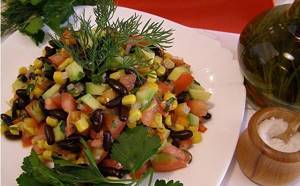
You will need to follow the following instructions:
- Place the onion in a medium-sized bowl and cover with cold water, set aside.
- Combine avocado, cilantro, lime juice, oil, garlic and salt in a food processor, blending until smooth and creamy.
- Immediately before serving, mix lettuce, corn, tomatoes and beans in a large salad bowl, drain the onion and add it to the rest of the ingredients along with the avocado dressing, mix evenly.
To create healthy recipes, you should combine foods with different benefits—lowering blood sugar, reducing inflammation, and promoting weight maintenance or weight loss.
The list of ingredients can be changed and adjusted at your discretion.
General principles of nutrition for diabetes mellitus
Glucose is a monosaccharide or simple carbohydrate. Is it really necessary to exclude foods rich in carbohydrates from the diet forever - especially if the diagnosis has already been made? No, because nutrition must be balanced.
There is only one rule regarding products containing substances that can harm patients. The prescribed daily intake must be strictly followed. Without special reference points, it is very difficult to calculate it. But there is a so-called “bread unit” - a concept that should be known to all diabetics.
“Bread unit” is a measure for carbohydrate-containing food. It is used for any products - both mono and polysaccharides in the composition. One unit is equal to 12-15 g of essential compounds absorbed by our body. When consuming this dose, the glucose level in our blood increases by 2.8 mmol/l. In this case, we need exactly 2 units of insulin to absorb nutrients.
The norm was introduced specifically for diabetics, for whom it is so important to constantly ensure that the amount of carbohydrates introduced into the diet corresponds to the insulin administered. If the balance is not maintained, the following conditions may develop:
- Hyperglycemia is an increase in blood glucose levels - up to 8 mmol on an empty stomach, more than 10 mmol after meals. Signs: dry mouth, weight loss, apathy, weakness, increased blood pressure.
- Hypoglycemia – a decrease in an important indicator – below 3.3 mmol/l. Signs: pallor, dizziness, loss of consciousness, weakness in the legs, rapid heartbeat, hunger, sweating, trembling, pale skin.
- Experts introduced the following ratio: 1 unit of bread is equivalent to 30 g of bread, half a glass of porridge (barley or buckwheat), one sour apple.
- The daily norm for a person with diabetes is from 18 to 25 units. How to take them correctly?
- Divide the total amount into several meals: breakfast, afternoon snack, lunch, snack, dinner. The largest share should be for main meals (about 3.5 units), 1-2 each for intermediate or snacks.
- Most foods containing polysaccharides (plant foods) should be eaten in the first half of the day.
Patients are concerned with the questions of what foods can be consumed for diabetes and which cannot be eaten, what kind of nutrition can be called correct for high glucose? To answer them, you need to decide on what principles the new diet is based, what the new regime should be.
- It is necessary to eat food at a certain time. You can't skip breakfast, lunch and dinner. The approximate scheme is as follows: first breakfast - at 8 or 9, snack - at 11 or 12, lunch - at 14-15, afternoon snack - 17, dinner, divided into two parts - at 19 and 21 or 22 hours. If you stick to this regimen, you can avoid the problem of hypoglycemia. This condition usually occurs three or four hours after insulin is administered.
- A diabetic should carefully monitor how much he weighs. Calculating your optimal weight is simple: to do this, you need to subtract 100 from your own height in centimeters. For example, the norm for a person who is 167 cm is 67 kg. Obesity should not be allowed - it leads to decreased sensitivity to insulin.
- Another principle of the diet is that nutrition should be complete. High blood sugar is not a reason to give up carbohydrates. When creating a menu, it is necessary to pay special attention to polysaccharides and products containing them: buckwheat, plant foods (vegetables, herbs). For some, it's especially difficult to forget about sugar. Instead, you can and should use natural substitutes that will help sweeten dishes and return them to their usual taste. Stevia will be a good alternative to forbidden sweets.
- Too small or insufficient portions are not allowed; food should promote satiety and not increase hunger or irritate the appetite.
- Diabetes is often accompanied by obesity. Proper nutrition for this disease should be aimed at reducing body weight. Special dietary products based on amaranth flour help with this, they help overcome the craving for overeating, are suitable for snacking, and do not lead to an increase in blood glucose levels.
- Particular attention is paid to the amount of fat in the diet. Their complete absence is unacceptable, since they are of great value to the body. However, it is necessary to control the consumption of foods that contain them. Exceeding the norm leads to weight gain and the development of atherosclerosis. The amount of fat should be approximately 30%. These are mainly vegetable oils (sunflower, flaxseed, olive, amaranth).
- Products that contribute to an increase in blood sugar are excluded: confectionery, almost all fruits, jams, confiture, preserves, chocolate, flour, dairy with a high percentage of fat, syrups, lamb, pork, margarine, spread, some cereals.
- The diet must contain food containing fiber - it does not provoke an increase in glucose, and helps to compensate for the deficiency of nutrients and energy.
Carbohydrates are the main source of fat. That is why they are included in the diet with caution. But this is not a reason to replace these substances with proteins or fats - our body needs them for health and normal functioning.
When creating a new diet, it is advisable to exclude fast carbohydrates and prefer slow ones. The former are found in the following products:
- Sweets.
- Bakery products.
- Pasta.
- Starch.
- Potato.
- Fast food.
- Fast food.
- Cookie.
Simple carbohydrates are prohibited, but complex carbohydrates found in vegetables are not. So switch to plant-based foods - it will help you stay healthy and energetic.
Ideal for diet:
- Cabbage (broccoli, Brussels sprouts, cauliflower, white cabbage).
- Laminaria (sea kale).
- Tomatoes (in limited quantities).
- Raw onions or green onions in salads.
- Mushrooms.
- Beans in pods.
- Various greens.
- Cucumbers.
- Celery.
- Patissons.
- Eggplant.
- Sweets, honey, confectionery products made from puff pastry and refined white flour - it is recommended to find a healthy alternative for them - stevia-based treats in moderation.
- Pastries and bread made from white flour are prohibited. It can be replaced with rye or bran, but in this case the daily requirement will be approximately 325 g.
- Salted and pickled vegetables and potatoes are excluded from the diet.
- All store-bought sauces are high in sugar, preservatives, fat, pepper and salt.
- Sweet fruits and berries, freshly squeezed juices.
- Whole and skim milk, condensed milk.
- Various types of canned food, instant food, packaged snacks.
- Syrups (maple, corn) and other easily digestible carbohydrates.
- Fatty meats and fish, lard, smoked meats.
- Any soups containing potatoes and rice, in fatty and strong broths.
It is also necessary to completely exclude from your diet foods containing dangerous trans fats:
- Margarine.
- Spread
- Fast food.
- Cookie.
- Cakes.
- Chips.
- Mayonnaise.
- Semi-finished products.

Here are the foods you need to exclude if you have diabetes - check out the list of prohibited foods to easily create the right menu. Diet is the main means of eliminating the symptoms of the disease and allowing you to stay in good shape.
We remind you that everything that is on the “black list” must be excluded from your diet forever - eat right and you will not have to deal with the consequences of your own weakness. If you look closely at the foods that are allowed, you will see the ingredients for a varied, tasty and filling diet. This:
- Lean meat, poultry, fish.
- Eggs, seaweed.
- Various seafood.
- Butter (butter, vegetable), cheese.
- Mushrooms.
- Some cereals, fruits, berries.
- Vegetables are mostly green.
The menu should include:
- Diabetic bread, rye and bran bread.
- Vegetable soups, including cold ones. The broth should not be strong.
- Dishes made from lean meat and poultry.
- Kefir, bio-yogurt, acidophilus and other low-fat fermented milk products (but not low-fat).
- Unsalted cheese.
- Eggs, light omelettes. Protein is recommended, yolk consumption is limited.
- Dishes from cereals (with restrictions within acceptable limits). You can prepare porridge from buckwheat, pearl barley, oatmeal. Not allowed: from semolina, rice.
- Low-fat fish - either baked (in the oven, grilled) or boiled.
- Green vegetables: raw, steamed, boiled, baked. Attention: heat treatment increases the glycemic index of the product.
- Fruits: sour apples, oranges.
- Sweets: jellies, candies, mousses and other treats containing stevia and other substitutes are allowed.
- Recommended drinks: tea, diluted vegetable juices, decoctions based on herbs and dried rose hips.
- You can add butter to first and second courses, or use vegetable oil as a salad dressing.
- Sauces: only homemade, salty and spicy are excluded, low-fat ones are allowed, based on a decoction of vegetables and herbs.
This is what a daily menu for a diabetic might look like:
- Breakfast (1) – boiled lean meat, green apple, tea.
- Breakfast (2) – steamed omelet or soft-boiled egg.
- Lunch – vegetarian cabbage soup without potatoes, baked fish.
- Afternoon snack – a glass of kefir, an apple or a handful of black currants.
- Dinner – boiled beef with asparagus.
- At night - kefir.
If one disease is accompanied by another (gastritis, duodenitis, ulcer, colitis), it is necessary to maintain the proposed diet, but avoid irritation of the stomach and intestinal mucosa, follow special rules for preparing dishes - steamed, mashed.
Do not forget that you should adhere to a fractional diet - 5-6 times a day. Failure to comply with the regimen can lead to hypo- or hyperglycemia. Be careful: do not skip main and additional meals and do not overeat.
In this article, we tried to talk in as much detail as possible about what you can and can’t eat if you have high blood sugar, gave the principles of a diet for diabetes and lists of foods that are prohibited and allowed. Do not forget that proper nutrition will help strengthen the body and prevent the development of the disease - create a menu taking into account the doctor’s recommendations.

